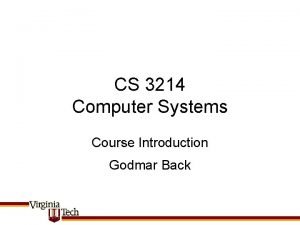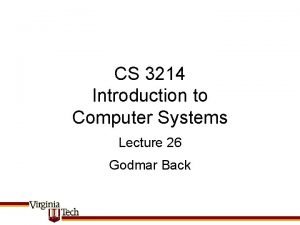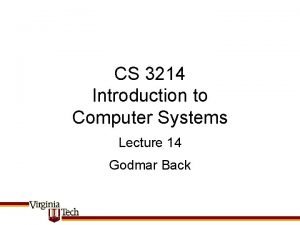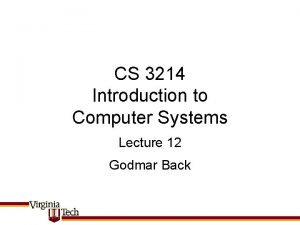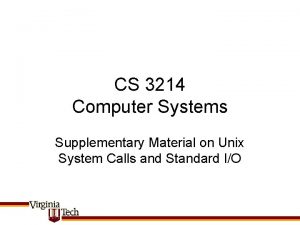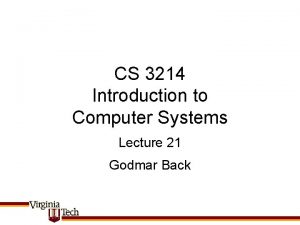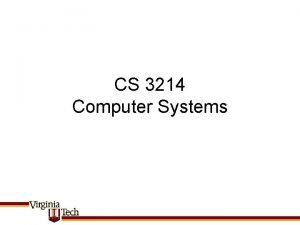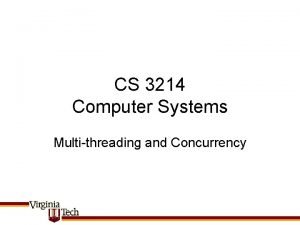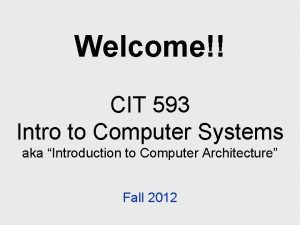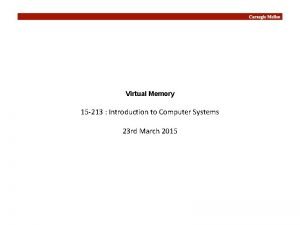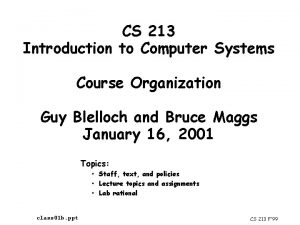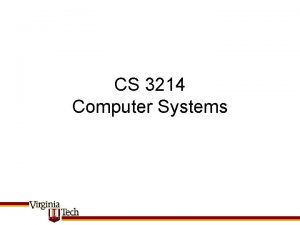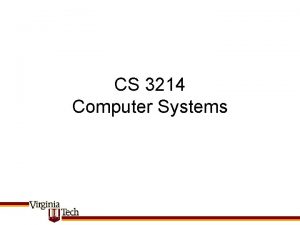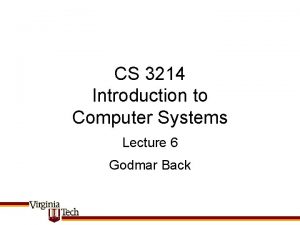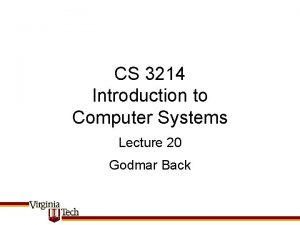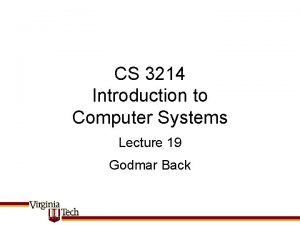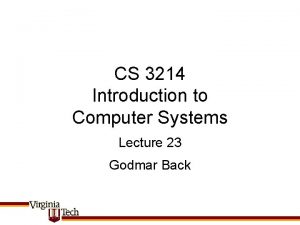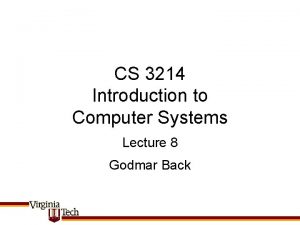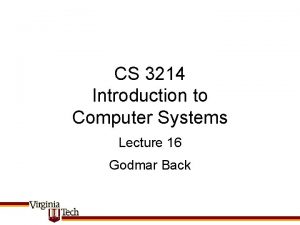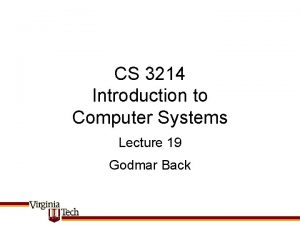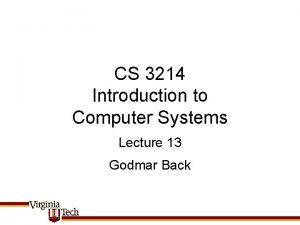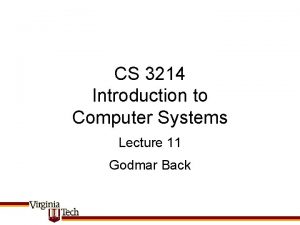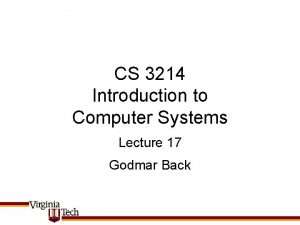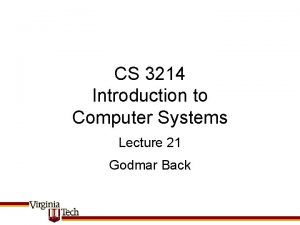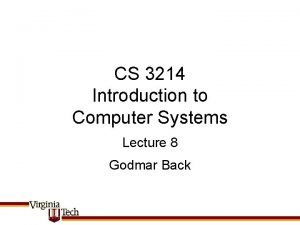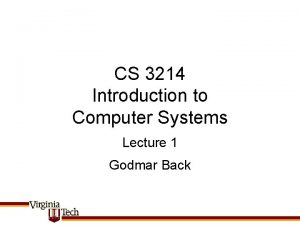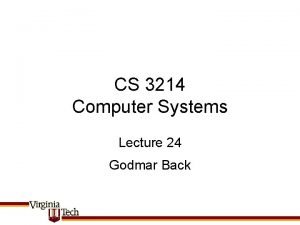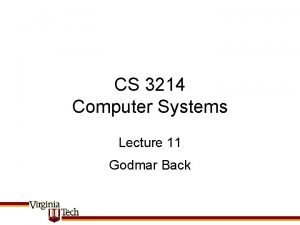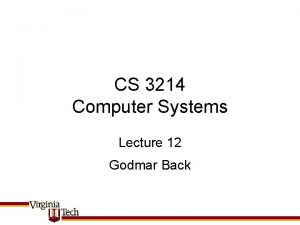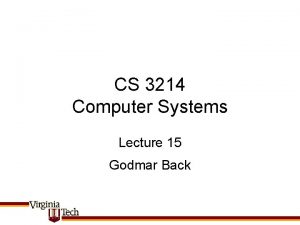CS 3214 Introduction to Computer Systems Lecture 14


























- Slides: 26

CS 3214 Introduction to Computer Systems Lecture 14 Godmar Back

Announcements • Read Chapter 8 & 11 • Exercise 9 due Oct 19 • Project 3 has been published – See forum – due Oct 30 • Midterm: Tuesday Oct 20 CS 3214 Fall 2009 12/2/2020 2

Part 3 THREADS AND PROCESSES CS 3214 Fall 2009 12/2/2020 3

Signals – Summary • Universal mechanism to notify a process of events – Internal events (memory access violation, process -internal timers, …) – External events • User-driven: ^C, ^Z • Resulting from other processes: explicit kill(2), or SIGCHLD • Resulting from kernel event: e. g. , SIGTTOU, SIGTTIN • Signal handler can change program state before returning – Extremely powerful CS 3214 Fall 2009 12/2/2020 4

Process Groups • Every process belongs to exactly one process group pid=20 pgid=20 pid=10 pgid=10 Foreground job Child pid=21 pgid=20 pid=22 pgid=20 Shell Background job #1 Background job #2 pid=32 pgid=32 Background process group 32 pid=40 pgid=40 Background process group 40 getpgrp() – Return process group of current process setpgid() – Change process group of a process Foreground process group 20 CS 3214 Fall 2009 12/2/2020 5

Process Groups, cont. • Every process can form a new process group by declaring themselves a leader – setpgid(0, 0) • But, this is not necessary – process groups can also be formed by having a parent place a process in its own or an existing group – E. g. , shell places all children belonging to the same pipeline into the same group • Process groups are populated simply by adding processes to them – Restriction: process group must be part of the same “session” – a concept that groups multiple procgroup’s. • See /proc/<pid>/stat to learn pgid of a process CS 3214 Fall 2009 12/2/2020 6

Managing Terminal Access • What if multiple processes wish to read from the terminal? – (default behavior: undefined) • Use process groups – One ‘foreground pgroup’ per terminal • Kernel will suspend (via SIGTTOU/TTIN) any process in background pgroup that attempts to read from terminal – Try: “vim &” • It’s up to shell to manage access to the terminal – Use tcsetpgrp() CS 3214 Fall 2009 12/2/2020 7

Signals & Concurrency • Signal handlers for external events can occur during *anytime* – Unless blocked – must think of signal handler as concurrent flow of control regular program handler signal delivered Signal handler returns sigreturn() user mode kernel mode CS 3214 Fall 2009 12/2/2020 8

Signals & Concurrency • Blocking a signal guarantees that signal handler execution will not occur even when signal is delivered – Will occur as soon as the signal is unblocked block(SIGNAL) signal pending unblock(SIGNAL) handler signal sent Signal handler returns sigreturn() user mode kernel mode CS 3214 Fall 2009 12/2/2020 9

Reentrancy • A function is said to be reentrant if it can be safely called again even while a call is still in progress (i. e. , has not returned) – Could be on a regular control flow path, e. g. recursion – Or 2 nd call could be from signal handler – Or (discuss this later in more detail) from another thread • Examples of functions that are not reentrant – inet_ntoa(), strtok() – uses private buffer – printf() – takes a lock • You cannot call non-reentrant functions from a signal handler for signal ‘s’ – Unless you prevent the delivery of ‘s’ during calls in your main program via { block(s); …. ; unblock(s); } CS 3214 Fall 2009 12/2/2020 10

Async-Signal Safety • ‘async-signal safe functions’ - safe to call from a signal handler – Provide the signal is allowed to occur (i. e. , is not blocked) while calls to these functions are in progress – else no issue arises • See list in man 2 signal. Includes waitpid(), etc. • The kicker: printf() is not safe to call in a signal handler – Frequent source of bugs (even in some textbook sample code…. !) – Can use ‘snprintf() + write(1, …)’ if needed CS 3214 Fall 2009 12/2/2020 11

Concurrent Accesses To Data Structures • Consider shell maintaining a list of jobs – Main program forks, adds jobs – SIGCHLD handler may reap jobs, perhaps remove jobs from joblist void list_insert (struct list_elem *before, struct list_elem *elem) { If signal arrives inside the elem->prev = before->prev; instructions doing the list elem->next = before; manipulation, signal handler will before->prev->next = elem; see inconsistent – calls to before->prev = elem; list_insert will lead to havoc } CS 3214 Fall 2009 12/2/2020 12

Strategy • Identify data structures shared between signal handler and main program – E. g. , everything the signal handler (or functions called from it) accesses • Then protect accesses to those data structures by blocking the signal around the access • Use ‘assert()’ – assert(esh_signal_is_blocked(SIGCHLD)); • Aside: the technique of delaying such interrupts is used inside OS in a very similar way, e. g. when devices trigger interrupts CS 3214 Fall 2009 12/2/2020 13

Nonlocal Jumps: setjmp/longjmp • Powerful (but dangerous) user-level mechanism for transferring control to an arbitrary location. – Controlled to way to break the procedure call/return discipline – Useful for error recovery and signal handling • int setjmp(jmp_buf j) – Must be called before longjmp – Identifies a return site for a subsequent longjmp. – Called once, returns one or more times • Implementation: – Remember where you are by storing the current register context, stack pointer, and PC value in jmp_buf. – Return 0 CS 3214 Fall 2009 12/2/2020 14

setjmp/longjmp (cont) • void longjmp(jmp_buf j, int i) – Meaning: • return from the setjmp remembered by jump buffer j again. . . • …this time returning i instead of 0 – Called after setjmp – Called once, but never returns • longjmp Implementation: – Restore register context from jump buffer j – Set %eax (the return value) to i – Jump to the location indicated by the PC stored in jump buf j. CS 3214 Fall 2009 12/2/2020 15

setjmp/longjmp Example #include <setjmp. h> jmp_buf buf; main() { if (setjmp(buf) != 0) { printf("back in main due to an errorn"); else printf("first time throughn"); p 1(); /* p 1 calls p 2, which calls p 3 */ }. . . p 3() { <error checking code> if (error) longjmp(buf, 1) } CS 3214 Fall 2009 12/2/2020 16

A Program That Restarts Itself When ctrl-c’d #include <stdio. h> #include <signal. h> #include <setjmp. h> sigjmp_buf buf; while(1) { sleep(1); printf("processing. . . n"); } } void handler(int sig) { siglongjmp(buf, 1); } bass> a. out starting processing. . . main() { restarting signal(SIGINT, handler); processing. . . if (!sigsetjmp(buf, 1)) processing. . . printf("startingn"); restarting else processing. . . printf("restartingn"); restarting processing. . . CS 3214 Fall 2009 Ctrl-c 12/2/2020 17

Limitation of setjmp/longjmp • Longjmp restores stack pointer – Thus activates a new stack frame – Stack frame must still be valid • Consequence: – Can only longjmp “up the stack” to functions that haven’t yet returned when longjmp() is called – repositioning the stack pointer automatically “destroys” intermediate stack frames • But does not call cleanup functions provided in some languages (e. g. C++ destructors or Java ‘finally’ clauses) – Longjmp’ing “down the stack” would “reactivate” already destroyed stack frames • Does not necessarily crash, but leads to unpredictable results • Think of setjmp/longjmp as a low-level mechanism to implement a variant of C++/Java style exceptions CS 3214 Fall 2009 12/2/2020 18

Summary • Signals provide process-level exception handling – Can generate from user programs – Can define effect by declaring signal handler • Some caveats – Very high overhead • >10, 000 clock cycles • Only use for exceptional conditions – Don’t have queues (exception: “real-time signals”) • Just one bit for each pending signal type • Nonlocal jumps provide exceptional control flow within process – Within constraints of stack discipline CS 3214 Fall 2009 12/2/2020 19

Unix File Descriptors • Unix provides a file descriptor abstraction • File descriptors are – Small integers that have a local meaning within one process – Can be obtained from kernel • Several functions create them, e. g. open() – Can refer to various kernel objects (not just files) – Can be passed to a standard set of functions: • read, write, close, lseek, (and more) – Can be inherited when a process forks a child CS 3214 Fall 2009 12/2/2020 20

Examples • 0 -2 are initially assigned – 0 – stdin – 1 – stdout – 2 – stderr – But this assignment is not fixed – process can change it via syscalls • int fd = open(“file”, O_RDONLY); • int fd = creat(“file”, 0600); CS 3214 Fall 2009 12/2/2020 21

Implementing I/O Redirection • dup and dup 2() system call • pipes: pipe(2) CS 3214 Fall 2009 12/2/2020 22

dup 2 #include <stdio. h> #include <stdlib. h> // redirect stdout to a file int main(int ac, char *av[]) { int c; int fd = creat(av[1], 0600); if (fd == -1) perror("creat"), exit(-1); if (dup 2(fd, 1) == -1) perror("dup 2"), exit(-1); while ((c = fgetc(stdin)) != EOF) fputc(c, stdout); } CS 3214 Fall 2009 12/2/2020 23

user view kernel view 0 1 The Big Picture 2 3 4 Process 1 0 1 open(“x”) Terminal Device File Descriptor Open File x open(“x”) close(4) File Descriptor 2 3 dup 2(3, 0) Process 2 CS 3214 Fall 2009 12/2/2020 24

Reference Counting • Multiple file descriptors may refer to same open file – Within the same process: • fd = open(“file”); fd 2 = dup(fd); – Across anchestor processes: • fd = open(“file”); fork(); • But can also open a file multiple times: – fd = open(“file”); fd 2 = open(“file”); – In this case, fd and fd 2 have different read/write offsets • In both cases, closing fd does not affect fd 2 • Reference Counting at 2 Levels: – Kernel keeps track of how many processes refer to a file descriptor –fork() and dup() may add refs – And keeps track of how many file descriptors refer to open file • close(fd) removes reference in current process CS 3214 Fall 2009 12/2/2020 25

Practical Implications • Number of simultaneously open file descriptors per process is limited – 1024 on current Linux, for instance • Must make sure fd’s are closed – Else ‘open()’ may fail • Number space is reused – “double-close” error may inadvertently close a new file descriptor assigned the same number CS 3214 Fall 2009 12/2/2020 26
 01:640:244 lecture notes - lecture 15: plat, idah, farad
01:640:244 lecture notes - lecture 15: plat, idah, farad Eecs 3214
Eecs 3214 Cs 3214 vt
Cs 3214 vt Cs 3214
Cs 3214 Cs 3214
Cs 3214 Cs 3214 fall 2021
Cs 3214 fall 2021 Cs 3214
Cs 3214 Cs 3214
Cs 3214 Cs 3214 vt
Cs 3214 vt Cs 3214
Cs 3214 Cs 3214
Cs 3214 Cit593
Cit593 15-213 introduction to computer systems
15-213 introduction to computer systems 15-213 introduction to computer systems
15-213 introduction to computer systems Advanced operating system notes
Advanced operating system notes Lecture sound systems
Lecture sound systems Lecture sound systems
Lecture sound systems Computer security 161 cryptocurrency lecture
Computer security 161 cryptocurrency lecture Computer aided drug design lecture notes
Computer aided drug design lecture notes Architecture lecture notes
Architecture lecture notes Microarchitecture vs isa
Microarchitecture vs isa Introduction to biochemistry lecture notes
Introduction to biochemistry lecture notes Introduction to psychology lecture
Introduction to psychology lecture Introduction to algorithms lecture notes
Introduction to algorithms lecture notes Decision support systems and intelligent systems
Decision support systems and intelligent systems Principles of complex systems for systems engineering
Principles of complex systems for systems engineering Embedded systems vs cyber physical systems
Embedded systems vs cyber physical systems


